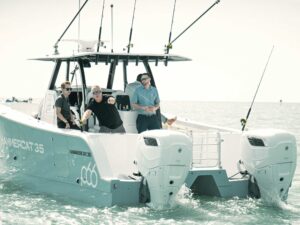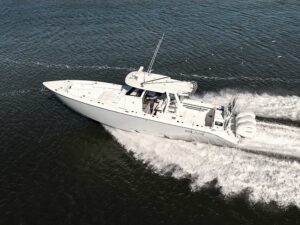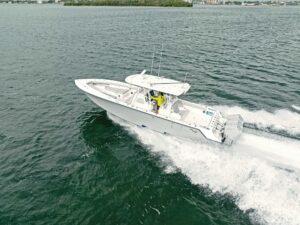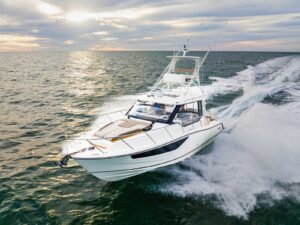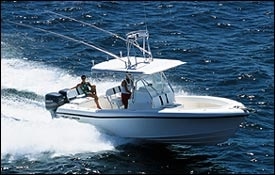
Ocean Master’s 27 has long been a hit among serious fishermen across the country because of its no-nonsense design and legendary construction. Ocean Master builds its boats to last, with overbuilt stringers and lots of glass for years of service without a lot of pampering.
Full-length stringers are bonded to the solid, half-inch-thick fiberglass hull for maximum strength, and Ocean Master even glasses the cap to the hull. Reverse chines act as spray rails to keep passengers dry, while the 40-degree entry cuts through waves to provide a smooth ride. The 27 is a relatively heavy boat, which also helps the ride immensely, but the hull is efficient enough so that speeds don’t suffer.
You can order the 27 in either a conventional notched-transom setup or with a full transom and an engine bracket. Our boat had the latter arrangement, and was powered by twin 200-hp Yamaha EFIs. At a 4000 rpm cruise, the 27 hit 37.8 mph, which is certainly respectable performance for a 27-footer with twin 200s. Wide-open, we reached 50 mph at 5400 rpm.
Drier, Smoother Ride
Evolutionary changes to the hull have made this possible. “The original 27 had wedges built into the stern to keep the bow down, but we removed those,” said Mark Hauptner, president of Ocean Master. “Now she rides with her bow up somewhat, and you can control the running attitude with the trim tabs.” That change and the addition of the chines/spray rails both contribute to the boat’s dry ride.
As we said, our test boat had a full transom with a bracket, which gives you more fishing room and creates some other opportunities, too. For example, it gives you room to add a second 35-gallon live well to complement the standard well in the deck. Ocean Master puts this second well on top of the transom. It also builds in two storage boxes in the transom corners, plus there’s a handy backrest and a cushion, both removable, that transform the transom into a passenger seat. There’s good inner-hull access along the forward edge of the transom.
The 27’s rocket launcher holds three rods and has a space below for a 94-quart Igloo cooler. Two in-deck fishboxes run fore and aft alongside the launcher. These boxes drain into the bilge, but you can have them equipped with macerators. There are two additional, smaller in-deck storage boxes forward, next to the console. The console itself has a three-sided surface to accept electronics, with the gauges and switches arranged above the helm. The console also has a recessed step for the helmsman’s feet – a nice touch for those long runs.
Thoughtful Design
The spacious subconsole area contains a full marine head – no porta-potty here! A U-zip flap conceals the oil tanks, which are filled through the front console seat, as is the fresh water tank. A large shelf aft holds the batteries, and our test boat even had an Armstrong swim ladder mounted in this space. Access to everything is very good, simplifying storage and maintenance.
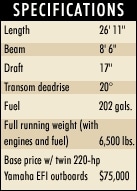
The raised casting deck forward contains a large, insulated fishbox that drains to the bilge, although a macerator can (and should) be added. Two smaller wing boxes hold more loose gear outboard of the fishbox. The 27 features 360-degree coaming pads, and our test boat had a clean bow with no rail. It also had flush-mounted cleats for a clean and uncluttered setup that was obviously designed by fishermen.
The optional T-top had one of the observation towers that have become so popular in South Florida. The tower is accessed through a zip-out flap in front of the console and provides some of the benefits of a full tower without all the expense and hassle.
Ocean Master’s latest version of the 27 has a much higher level of fit-and-finish than older versions did, showing that it’s a proven design that is improving with age.
Ocean Master, Riviera Beach, FL; (561) 840-0448; www.oceanmasterboats.com

